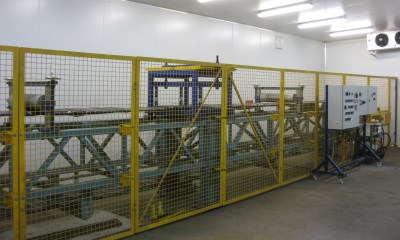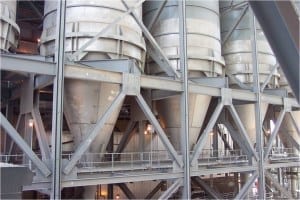Services List
-
Services By Handling Problems

Conveyor Belt and Conveyor Accessories Testing
Belt conveyors play a major role in bulk materials handling operations. They combine versatility and reliability and, in view of their inherent simplicity of operation, they are suited to the conveying of a wide range of bulk materials.
They may be used effectively for the movement of bulk materials over both short and long distances.
In the latter case, the adaptability of their design and construction permits them to operate over undulating terrain.
Testing of Belt Conveyor Accessories
- Indentation Rolling Resistance Measurement
- Motion Resistance Measurements
- Idler Roll Testing
- Rim Drag
- Noise Level
- Breakaway, TIR and Dynamic Imbalance Testing
- Testing of Pulley Lagging
- Testing of Conveyor Belt Cleaning Systems

Belt Testing according to Australian Standards
Testing can be conducted for both steel cord belts and textile reinforced belts. The test procedures available for steel cord belts (AS 1333) comprise the determination of:
- Steel Cord Pitch
- Cord Breaking Force
- Static Pull-out Strength
- Laminate Adhesion
- Dynamic Cord Pull-out Fatigue Resistance
- Cord elastomeric Compound Penetration
For textile reinforced conveyor belts the following tests can be conducted:
- Thickness of Belting and Rubber Covers (AS 1334.2)
- Tensile Strength and Elongation (AS 1334.3)
- Troughability (AS 1334.4)
- Ply Adhesion (AS 1334.7)
- Resistance to Tear (AS 1334.8)
Tests for the rubber covers according to AS 1683 can be conducted for both belt types:
- Tensile Testing of vulcanised or thermoplastic Rubbers (AS 1683.11)
- Abrasion Resistance (AS 1683.21)

-
Services By Industry

Conveyor Belt and Conveyor Accessories Testing
Belt conveyors play a major role in bulk materials handling operations. They combine versatility and reliability and, in view of their inherent simplicity of operation, they are suited to the conveying of a wide range of bulk materials.
They may be used effectively for the movement of bulk materials over both short and long distances.
In the latter case, the adaptability of their design and construction permits them to operate over undulating terrain.
Testing of Belt Conveyor Accessories
- Indentation Rolling Resistance Measurement
- Motion Resistance Measurements
- Idler Roll Testing
- Rim Drag
- Noise Level
- Breakaway, TIR and Dynamic Imbalance Testing
- Testing of Pulley Lagging
- Testing of Conveyor Belt Cleaning Systems

Belt Testing according to Australian Standards
Testing can be conducted for both steel cord belts and textile reinforced belts. The test procedures available for steel cord belts (AS 1333) comprise the determination of:
- Steel Cord Pitch
- Cord Breaking Force
- Static Pull-out Strength
- Laminate Adhesion
- Dynamic Cord Pull-out Fatigue Resistance
- Cord elastomeric Compound Penetration
For textile reinforced conveyor belts the following tests can be conducted:
- Thickness of Belting and Rubber Covers (AS 1334.2)
- Tensile Strength and Elongation (AS 1334.3)
- Troughability (AS 1334.4)
- Ply Adhesion (AS 1334.7)
- Resistance to Tear (AS 1334.8)
Tests for the rubber covers according to AS 1683 can be conducted for both belt types:
- Tensile Testing of vulcanised or thermoplastic Rubbers (AS 1683.11)
- Abrasion Resistance (AS 1683.21)

-
Services By Material Type

Conveyor Belt and Conveyor Accessories Testing
Belt conveyors play a major role in bulk materials handling operations. They combine versatility and reliability and, in view of their inherent simplicity of operation, they are suited to the conveying of a wide range of bulk materials.
They may be used effectively for the movement of bulk materials over both short and long distances.
In the latter case, the adaptability of their design and construction permits them to operate over undulating terrain.
Testing of Belt Conveyor Accessories
- Indentation Rolling Resistance Measurement
- Motion Resistance Measurements
- Idler Roll Testing
- Rim Drag
- Noise Level
- Breakaway, TIR and Dynamic Imbalance Testing
- Testing of Pulley Lagging
- Testing of Conveyor Belt Cleaning Systems

Belt Testing according to Australian Standards
Testing can be conducted for both steel cord belts and textile reinforced belts. The test procedures available for steel cord belts (AS 1333) comprise the determination of:
- Steel Cord Pitch
- Cord Breaking Force
- Static Pull-out Strength
- Laminate Adhesion
- Dynamic Cord Pull-out Fatigue Resistance
- Cord elastomeric Compound Penetration
For textile reinforced conveyor belts the following tests can be conducted:
- Thickness of Belting and Rubber Covers (AS 1334.2)
- Tensile Strength and Elongation (AS 1334.3)
- Troughability (AS 1334.4)
- Ply Adhesion (AS 1334.7)
- Resistance to Tear (AS 1334.8)
Tests for the rubber covers according to AS 1683 can be conducted for both belt types:
- Tensile Testing of vulcanised or thermoplastic Rubbers (AS 1683.11)
- Abrasion Resistance (AS 1683.21)












